1. Introduction
With the development of social media, information dissemination has become more and more efficient, and users have become more and more extensive. Enterprises increasingly use social media advertising for advertising products and take advantage of the live streaming channels on social media platforms to promote goods to gain revenue. Consumers and influencers, as audience and disseminators of social media advertisements, have become two major groups on social media, among which influencers have become the bridge between enterprises and consumers on social media [1,2]. For example, some nutrition and health products companies will select health-related influencers to publicize and sell their products and, at the same time, do some popular science through the influencers’ videos [3,4]. Since consumers have basic knowledge about nutrition, they can choose safer and higher quality nutrition products, so good manufacturers can make more money and produce more advanced products [3,5]. This can create a virtuous circle, and the health of the whole society may be improved. Thus, the questions of whether social media advertising affects product sales and how the characteristics of consumers and influencers affect the effectiveness of advertising are worth exploring.
In the era of social media widely serving businesses, the effect of social media advertising has a direct impact on corporate earnings, and consumers and influencers are essential components of social media platforms [6]. Therefore, this study aims to summarize the characteristics of consumers and influencers that might have an impact on the advertising effect through questionnaire analysis and data analysis. Then preliminarily, find out the ideas and methods to depict the portraits of consumers and influencers and assist enterprise decision-makers in improving the quality of decision-making and using social media platforms to improve their economic benefits.
Based on the social media advertising of nutrition and health products, this research seeks out the characteristics of consumers and influencers which impact on the advertising effect to provide ideas and a theoretical basis for future research on portraying the portraits of consumers and influencers based on social media extensive data analysis. In the future, with the improvement of the accuracy of using social media big data to depict the portraits of consumers and influencers, enterprises could use this technology to improve their intelligence and management capabilities to maintain their competitiveness to obtain higher economic benefits [6,7]. At the same time, advertising products on social media can also convey more health knowledge to consumers, thus improving social health awareness and achieving positive social benefits.
The research results show that social media advertising will increase the sales of products, and many characteristics of consumers and influencers will affect the advertising effect and then affect the sales of products.
The rest of this paper is organized as follows. Section 2 overviews the proposed methods, including questionnaire analysis, data collection, and analysis. Section 3 shows the experimental results, from customers and influencers, through visual display and detailed explanation. Section 4 discusses the part that could be improved in the future. Section 5 makes an overall summary of this study, including the conclusion and significance.
2. Methods
Consumers and influencers are two crucial factors that affect the effectiveness of marketing behavior on social media platforms. Therefore, this study is divided into two parts based on consumers and influencers. In the consumer research section, this paper collects data through a questionnaire survey; In the research section of the influencer, this paper collects live streaming data from social media platforms manually. This paper uses data analysis tools to analyze and create tables and charts for the collected data. Figure 1 shows the method of consumer research.
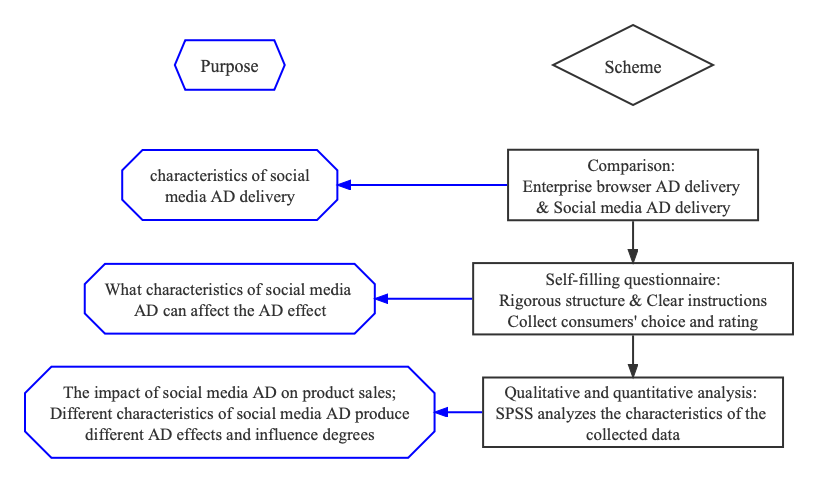
Figure 1: Method of consumer research.
2.1. Consumer Research
2.1.1. Information Acquisition
In the scheme, the data source is the questionnaire. Moreover, the exact method is collecting relatively subjective consumer information data through questionnaires and analyzing the characteristics of the collected information with analysis tools such as SPSS. In addition, this paper selects the nutritional supplement industry as the target industry for research and collecting relevant information. The information collected includes the basic information of the respondents (gender, age, income.), whether consumers have accepted the promotion on social media platforms and purchased nutrition products, the reasons for consumers to buy products, the impact of different factors in social media advertising on the purchase behavior, and the evaluation on social media of consumers on the purchased products. This paper hopes to follow this version of the scheme for research to understand the characteristics of social media advertising and analyze the impacts of the different characteristics on advertising effectiveness from consumers’ perspective [8].
2.1.2. Research Methods
Literature reading: During the research process, this paper acquires the relevant information and consumer behavior knowledge of the research target industry, namely the nutrition supplement industry, through literature reading to provide theoretical support for the design of the questionnaire and the implementation of the project.
Comparative study: This paper explores the characteristics of social media platform advertising by comparing the differences between traditional advertising delivery mode and social media advertising delivery mode to understand the new features of social media advertising in all aspects and develop a more valid questionnaire [9].
Questionnaire: Figure 2 shows the questionnaire structure. In this scheme, the questionnaire is the source of information. First, the respondents are classified by setting the basic information (gender, age, income.) of the respondents. After that, the study set different questions according to whether consumers have accepted the social media platform advertising of the nutrition supplement product brand, whether they have purchased the product, and the reasons for consumers’ behavior. Then this research explores the impact of different factors on consumer behavior through the 1-5 scoring model, including the relevant factors of social media advertising and product evaluation. Finally, the interviewees are asked whether they would evaluate and recommend products on social media.
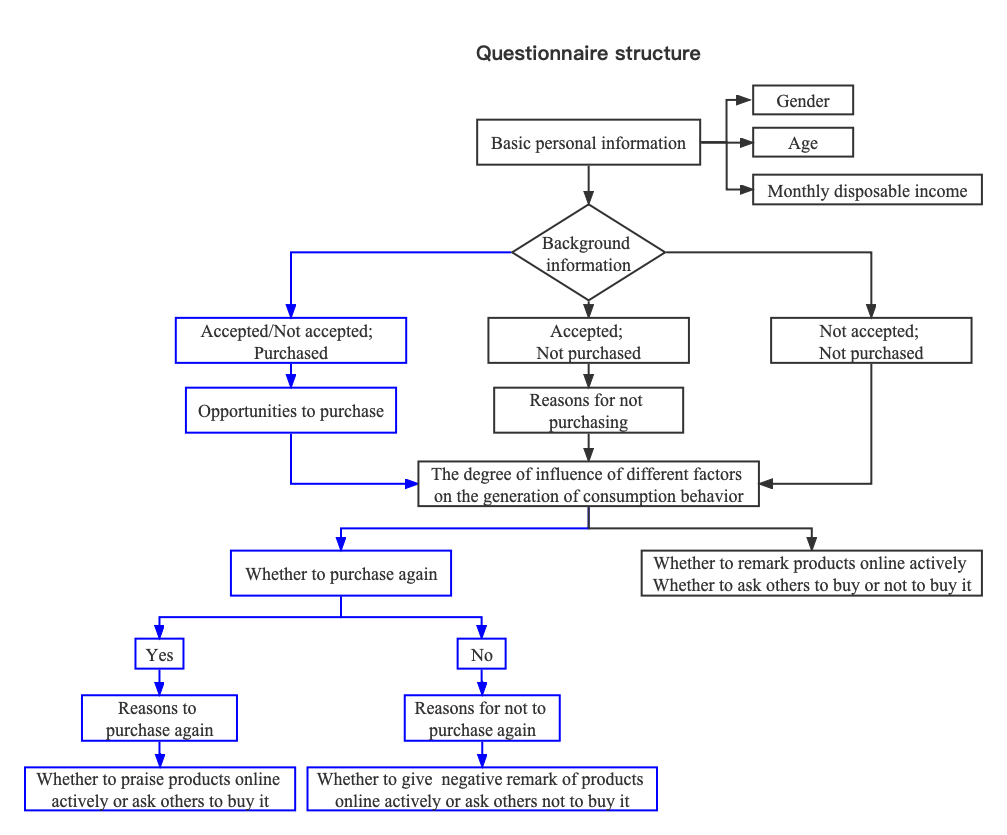
Figure 2: Questionnaire structure.
Data analysis: Information data is the primary data form in the scheme. However, the information data is relatively subjective and cannot directly reflect the problem [10]. Therefore, this paper analyzes the collected information data through SPSS and other analysis tools, explore its characteristics, and finally reach a conclusion [11].
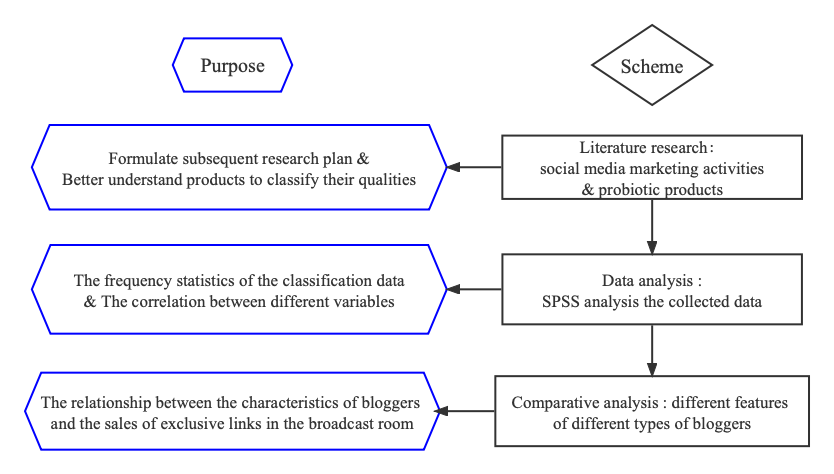
Figure 3: Method of influencer research.
2.1.3. Implementation of the Scheme
This paper collects more than 200 questionnaires. The respondents are distributed in different age groups and have different income, which is of certain research significance. Figure 3 shows the method of influencer research.
2.2. Influencer Research
Based on the research goal of combining consumers with influencers to study the effect of marketing activities on social media platforms, in this stage of research, this paper collects relevant data from live streaming channels on social media platforms and use SPSS and other analysis tools for data analysis, hoping to have an accurate understanding of the impact of influencers on marketing activities on social media platforms. In addition, this paper hopes to combine this research results with the previous results on consumers to get a more comprehensive conclusion.
2.2.1. Data Collection
This paper collects data from the live streaming channels, which sells probiotic health products from 8: 00 pm to10: 00 pm. First, the exclusive links of influencers can directly reflect the influence of influencers on marketing activities [12]. Therefore, this paper chooses the sales of exclusive links of live influencers as the standard to evaluate the influence of influencers on marketing activities. In addition, this paper collects data that can reflect the characteristics of the influencer and other data that may impact the sales of exclusive links. The specific data include the type of the influencers (professional/non-professional, whether there are video works), the number of fans of the influencers, the quality of the products (based on the study of probiotics), the number of video works of the influencers, the number of popular science video works and the number of advertising video works of the professional influencers.
2.2.2. Research Methods
Literature research: At this stage, this paper first studies the relevant literature on the characteristics and functions of influencers in social media marketing activities to determine the scope of data collection and rationally formulate subsequent research plans. In addition, to better understand the products and classify the product quality in the subsequent data collection process, this paper also conducts a reading study on the literature related to probiotic products.
Data analysis: This paper uses SPSS to analyze the collected data. Firstly, the frequency statistics of the main classification data (influencer type, product quality) are carried out. Then the correlation between different variables is analyzed. Finally, a chart is made to display the analysis results visually.
Comparative analysis: This paper further analyzes the characteristics of the collected data through comparative analysis. For example, this paper compares different types of influencers and studies the relationship between the characteristics of different influencers and the sales of exclusive links in the live streaming channels.
3. Experimental Results and Analysis
3.1. Questionnaire from Customers
This paper collects 227 questionnaires. Table 1 shows the results of the background information part, which asked whether participants had purchased nutrition products and whether they had accepted nutrition product advertisements on social media. Among all the respondents, 99 people chose the option of “accepted, not purchased,” followed by “accepted, purchased”(62), “not accepted, not purchased”(50), and “not accepted, not purchased”(16). According to the preliminary judgment, 79.49% of the people who have bought nutrition products have received nutrition product advertising, so social media advertising will positively impact consumer behavior.
Table 1: Experience of nutrition consumption.
Frequency | Percentage | Effective percentage | accumulative percentage | |
accepted, purchased | 62 | 27.3 | 27.3 | 27.3 |
not accepted, purchased | 16 | 7.0 | 7.0 | 34.4 |
not accepted, not purchased | 50 | 22.0 | 22.0 | 56.4 |
accepted, purchased | 99 | 43.6 | 43.6 | 100.0 |
total | 227 | 100.0 | 100.0 |
Figure 4 shows that among the 78 respondents who had purchased nutritional products, 61 were motivated by personal needs, 28 respondents said that the recommendation of people around them affected their purchase behavior, and 17 respondents said they were influenced by brand advertising. In addition, the three options of live streaming promotion, bloggers’ recommendation and good comments on the network were each selected by 4-8 respondents. According to this result, it can be indicated that in addition to personal needs, receiving external recommendation information, whether in reality or on social media, will encourage people to make purchase decisions.
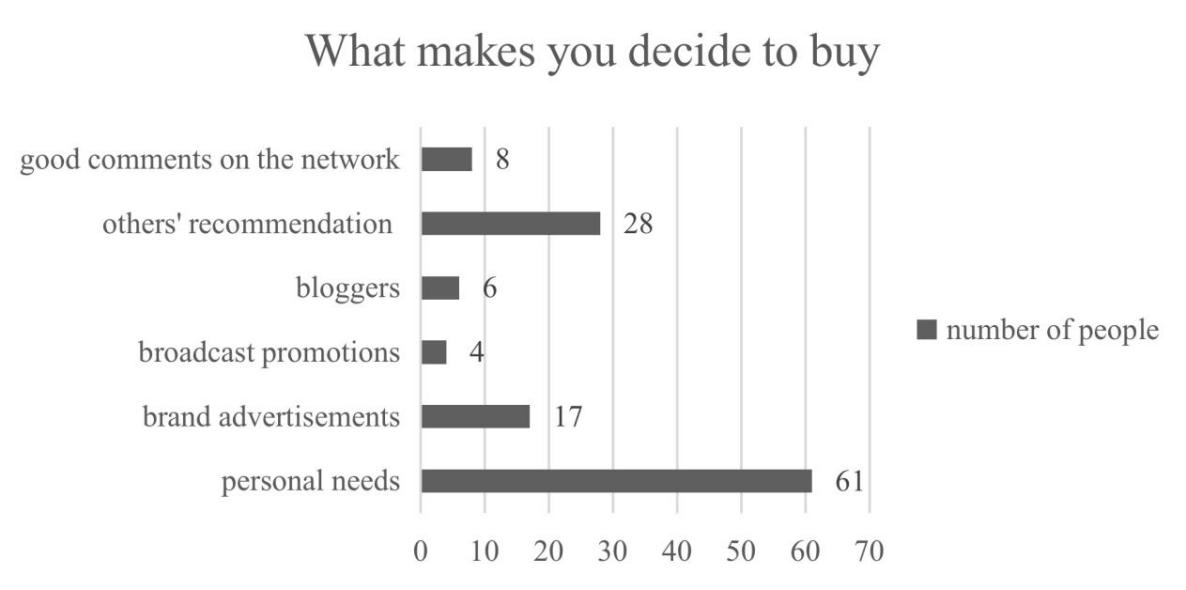
Figure 4: Opportunities to buy.
Table 2 shows information about the 99 respondents who “accepted, not bought”. It can be seen that the lack of purchase demand is the main reason why they had not purchased nutrition supplement products. Meanwhile, although social media advertising is not the main reason for inhibiting purchase decision, it is not accepted by every network user.
Table 2: The reasons of “accepted, not bought”.
Reason | Count |
No demand | 45 |
No interest | 56 |
Antipathy to advertising push | 32 |
Mistrusted marketing means | 31 |
Negative comments from acquaintances or KOL | 5 |
Too many negative comments | 4 |
A tight budget | 9 |
Other reasons | 1 |
Figure 5 shows the influence of different factors on purchase behavior, like “the times of receiving advertising,” “the number of people in the broadcast room,” “the magnitude of fans of the promotion influencer,” and so on. This part of research is conducted by using the matrix slider. The value from 0 to 5 indicates the gradually deepening influence. The collected data indicate that “the times of recommendation by people around” and “the proportion of good product evaluation” are generally more critical. The authors speculate that nutritional supplements affect the human body, and the recommendation of people around them is often trusted. However, the score of “the proportion of good product evaluation” is no less than the score of it, proving that the product reputation also has an important impact on the purchase decision. What’s more, different groups have some differences in the evaluation. For example, in the group “not accepted, not bought,” people think that “the times of recommendation by people around” and “the proportion of good product evaluation” are still more critical than other factors, but the impacts are less than the impacts of them in other groups. Overall, the influence of social media advertising may be as important as other influence factors, which reflects the great influence of social media on consumption behavior in today’s society.

Figure 5: The influence of factor on the purchase behavior.
Table 3 and Figure 6 show that among the people who had purchased nutritional products,” 59 will repurchase, and 19 will not. Among the 59 people, 71.19% will repurchase the products because of the good product effects while 84.21% of the 19 people who are not willing to repurchase are affected by the unfulfilling effects. The data also has the following characteristics. Among the 78 people who have purchased nutritional health products, 29 people think the products are of little effect, including 13 people find the products no obvious effect but hope to continue to try and 16 people find the product effects not as good as the publicity and will stop buying. Among those respondents, the number of people deciding to repurchase is roughly equal to those who do not. Thus, the effects of nutritional health products may vary from person to person, so when the product effects are not good enough, people do not necessarily stop buying the products immediately.
Table 3: Reasons for whether to repurchase.
Reasons for repurchase again | |
Reason | count |
Good product effect | 42 |
No obvious effect but hope to continue to try | 13 |
Other reasons | 4 |
Reasons for not repurchase again | |
Reason | Count |
The effect is not as good as the publicity | 16 |
Other reasons | 3 |
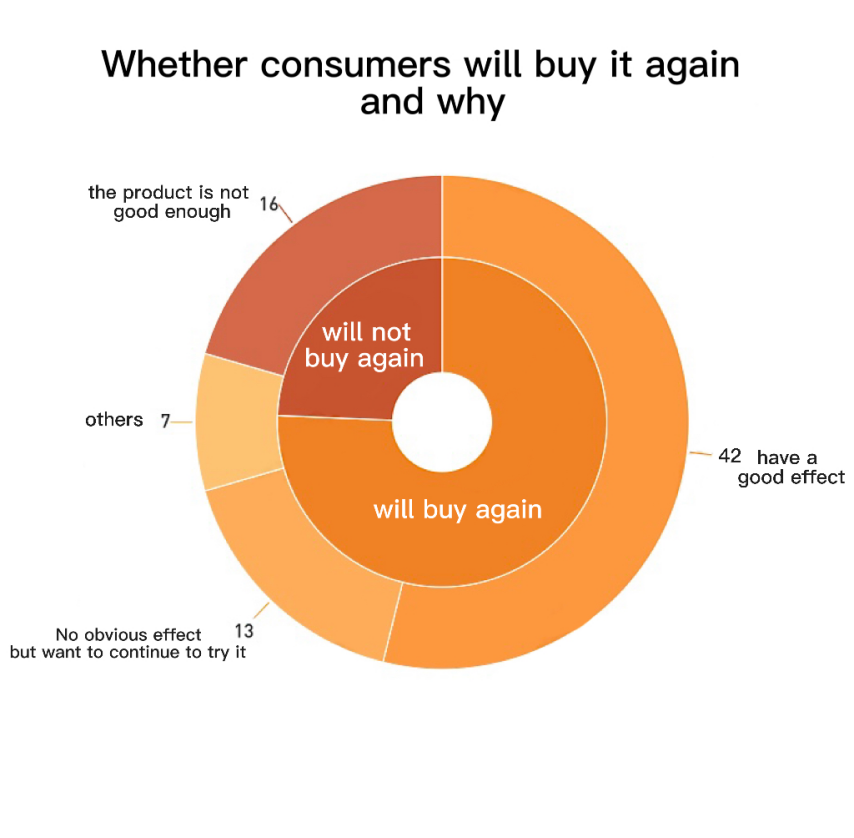
Figure 6: Whether consumers will buy it again and why.
Table 4 shows that among the “will buy again” group, 91.53% of the respondents will praise the product or recommend others to buy it on their initiative. Among the “will not buy again” group, 62.50% will neither actively evaluate the product online nor actively ask others not to buy it. Therefore, the author finds an interesting phenomenon that people who think the product is good are more likely to become promoters who improve the reputation of the product. On the other hand, those who think the product is not that good are not likely to try to make the reputation of the product decline.
Table 4: Whether to give some feedbacks.
Whether people who will purchase it again will praise products online actively or ask others to buy it | ||||
Will praise it online, will ask others to buy it | Not praise it online, will ask others to buy it | Not praise it online, not ask others to buy it | Will praise it online, not ask others to buy it | |
Quantity | 27 | 22 | 5 | 5 |
Percentage | 45.76% | 37.29% | 8.47% | 8.47% |
Whether people who will not purchase it again will give negative remark of products online actively or ask others not to buy it | ||||
Will give negative remark, will ask others not to buy it | Not give negative remark, will ask others not to buy it | Not give negative remark, not ask others not to buy it | Will give negative remark, not ask others not to buy it | |
Quantity | 2 | 0 | 10 | 4 |
Percentage | 12.50% | 0.00% | 62.50% | 25.00% |
3.2. Influencer’s Data from Social Platform
This study randomly collects 28 sets of data from TikTok’s live streaming channels. The data are mainly about influencers promoting probiotics products in their live streaming channels and the quality of the promoted probiotics products. For influencers, they are first classified into video influencers and non-video influencers according to whether they have video works and whether they mainly attract fans by posting videos. Then, according to whether they master professional knowledge related to the product, they are classified into professional influencers and non-professional influencers. Therefore, influencer accounts used for making profits on today’s social media can be divided into four categories: professional video influencers, non-professional video influencers, professional non-video influencers, and non-professional non-video influencers. Table 5 shows that non-professional video influencers account for the largest proportion of the 28 influencers, followed by professional video influencers.
Table 5: Categories of influencers.
Number | Proportion | |
Non-professional non-video influencers | 4 | 14.3 |
Professional non-video influencers | 4 | 14.3 |
Non-professional video influencers | 12 | 42.9 |
Professional video influencers | 8 | 28.6 |
Total | 28 | 100.0 |
For all types of influencers, this study collects the number of followers and sales of products of the accounts of influencers. Table 6 shows that the mean number of fans of professional video influencers is lower. However, Table 7 shows that video influencers’ average sales of products is higher than that of non-video influencers. In comparison, the sales of products promoted by professional video influencers are much higher than that of non-professional influencers. The author infers that video influencers can generate more connections with consumers through their videos, so they produce higher sales. Among them, the identity of professional influencers may enable them to seem more reliable, so they have more advantages when selling health-related products. Table 8 shows positive correlation between sales of products and the number of fans when the number of fans is no more than 5 million. But the relationship between these two figures will 0become more complex when the number of fans exceeds 5 million. To conclude, professional video influencers with a certain number of fans can help to attain the most sales, so they have higher commercial value.
Table 6: The average number of fans.
Professional video influencers | Professional non-video influencers | Non-professional non-video influencers | Non-professional video influencers | |
Average number | 206.4375 | 43.5850 | 60.8500 | 1543.8083 |
Table 7: Categories of influencers and the average sales.
Categories of influencers | the average sales of products |
Non-professional non-video influencers | 5020 |
Professional non-video influencers | 332 |
Non-professional video influencers | 7838 |
Professional video influencers | 13166 |
Table 8: The number of fans and the average sales.
The number of fans | The average sales of products |
Under 10k | 653 |
10k-100k | 4882 |
100k-1m | 7908 |
1m-5m | 12353 |
5m-10m | 9307 |
10m-50m | 821 |
Over 50m | 4986 |
Considering that professional video influencers are more closely connected to consumers and products, an in-depth study of their characteristics may be more valuable. Therefore, this study specifically collected the total number of videos posted by this type of influencer from January 1st, 2023 to April 12th, 2023, as well as the number of videos containing popular science and advertising content. Table 9 shows that sales of products has no positive correlation with the number of advertisements but has a positive correlation with the number of popular science videos. Hence, influencers with fewer advertisements sell less products because of their capacity to promote goods in general. Fewer businesses are looking for them to promote. However, too many advertisements may make the video less appealing to consumers and thus reduce the influencers’ ability to promote.
On the other hand, unlike the influence of the number of advertisements, popular science videos will further stimulate consumers’ purchase demand. It can be inferred that maybe popular science videos can transmit more knowledge about probiotics products to consumers so that consumers can realize the importance of probiotics products to the human body and could learn the way to select high-quality probiotics products and will be more willing to purchase them. Therefore, the advertising frequency is supposed to be moderate. And the more popular science videos, the more sales might be attained.
Table 9: Relationship between average sales and number of popular science videos and advertisements.
average sales | ||||
number of popular science videos | number of advertisements | |||
1-5 | 5-10 | 1-5 | 5-10 | >10 |
1694 | 4061 | 1748 | 11000 | 1694 |
For the quality of probiotics, this paper quantified the product quality according to the strain type of the product, the number of strains of the product, whether the activity of the strain has been marked, and whether it has been certified by an authoritative testing agency. Table 10 shows that the quality and sales of products sold by professional video influencers are all the highest. This shows that professional influencers can achieve the goal of bringing good products to more consumers.
Table 10: The quality and sales of products.
Categories of influencers | average sales of products | average quality of products |
Non-professional non-video influencers | 5020 | 3.1 |
Professional non-video influencers | 332 | 3.5 |
Non-professional video influencers | 7838 | 3.5 |
Professional video influencers | 13166 | 4.0 |
4. Discussion
In marketing activities on social media platforms, influencers and consumers are two key elements that have essential impacts on the effectiveness of marketing activities. This study uses a questionnaire survey to study the consumer’s response to social media marketing behaviour, uses the information about the live streaming channels on TikTok to analyse the impact of influencers, and explores how these two elements affect the marketing activities of enterprises on the social media. This study carries out the research from both qualitative and quantitative perspectives.
In the future, this study hopes to collect relevant data through more professional channels, build a portrait of consumers and influencers based on big data and combine the two to provide more accurate suggestions for corporate social media marketing activities.
In addition, in the data collection process, this study finds some marketing chaos in the live streaming channels on social media platforms, such as using the same link between different live streaming channels, but modifying the link name to make it look like an exclusive link to accumulate sales. This reduces the amount of data available for research and the accuracy of data. This study hopes to use standardized public data of live-streaming goods to ensure analysis accuracy in an environment where social media marketing is strictly regulated.
5. Conclusions
In conclusion, the characteristics of both consumers and influencers will impact advertising effectiveness and product sales. For customers, external recommendations, such as social media advertising, facilitate purchase decisions. Second, product reputation is the most popular influencing factor for consumers. Third, product quality significantly impacts whether to re-consume, and the product characteristics of nutritional health products can neutralize the negative impacts of product quality on purchasing decisions. Finally, it can be seen from how consumers influence product reputation that it is easier to improve reputation than to reduce it. Under these premises, combined with the characteristics of social media that it can spread product praise quickly and widely, product reputation can be further improved with social media assistance. Therefore, for enterprises, while improving product quality, social media advertising should be used to expand product awareness and improve product reputation to gain higher sales. For example, advertising funds could be mainly allocated to influencers on social media to expand awareness and, simultaneously, to comment sections on social media to maintain and improve product reputation.
For influencers, first, video influencers generate higher sales than non-video influencers, among which professional video influencers have relatively few fans and produce the most sales. Second, the advertising frequency should be moderate. And the number of popular science videos has a positive correlation with the sales of products. Third, professional influencers can realize the purpose of bringing good products to more consumers. Therefore, enterprises choosing professional influencers to promote their products can not only save some publicity costs due to the relatively small number of fans of this kind of influencer, but also attain better publicity effects because of the professional identity and relevant knowledge of these influencers. What’s more, choosing influencers with more popular science videos and moderate advertising frequency can help to save publicity costs and lead to better results. Finally, considering the characteristics that consumers value brand reputation, enterprises should strive to improve product quality because even though the production cost is high, under the publicity of professional influencers, enterprises can maintain a good reputation and achieve higher sales simultaneously.
References
[1]. Honglei Zhang a , Zhenbo Zang b,* , Hongjun Zhu c , M. Irfan Uddin d , M. Asim Amin.H. Zhang et al. (2022).Big data-assisted social media analytics for business model for business decision making system competitive analysis. Information Processing and Management 59 (2022) 102762
[2]. Denish Shah, Emily Webster, Gurpreet Kour, Consuming for content? Understanding social media-centric consumption, Journal of Business Research, Volume 155, Part B,2023,113408,ISSN 0148-2963
[3]. Taha A. Kass-Hout, Hend Alhinnawi, Social media in public health, British Medical Bulletin, Volume 108, Issue 1, December 2013, Pages 5–24, https://doi.org/10.1093/bmb/ldt028
[4]. Ali, T., Alam, A., & Ali, J. (2021). Factors Affecting Consumers’ Purchase Behaviour for Health and Wellness Food Products in an Emerging Market. Global Business Review, 22(1), 151–168. https://doi.org/10.1177/0972150918795368
[5]. Renga, Giuseppe. From YouTube to Protein Powder: How Social Media Influences the Consumption and Perception towards Nutritional Supplements. ZHAW Zürcher Hochschule für Angewandte Wissenschaften, 2017, https://doi.org/10.21256/zhaw-2091.
[6]. Bhatli, D., Mejri, C.A. (2015). The Influence of Social Media on Consumption Practices. In: Kubacki, K. (eds) Ideas in Marketing: Finding the New and Polishing the Old. Developments in Marketing Science: Proceedings of the Academy of Marketing Science. Springer, Cham. https://doi.org/10.1007/978-3-319-10951-0_289
[7]. Corné Dijkmans, Peter Kerkhof, Camiel J. Beukeboom, A stage to engage: Social media use and corporate reputation, Tourism Management, Volume 47, 2015, Pages 58-67, ISSN 0261-5177, https://doi.org/10.1016/j.tourman.2014.09.005.
[8]. Gabriels, G., Lambert, M. Nutritional supplement products: does the label information influence purchasing decisions for the physically active?. Nutr J 12, 133 (2013). https://doi.org/10.1186/1475-2891-12-133
[9]. Dezhi Yin, Sabyasachi Mitra, Han Zhang (2016) Research Note—When Do Consumers Value Positive vs. Negative Reviews? An Empirical Investigation of Confirmation Bias in Online Word of Mouth. Information Systems Research 27(1):131-144. https://doi.org/10.1287/isre.2015.0617
[10]. Bettina von Helversen, Katarzyna Abramczuk, Wiesław Kopeć, Radoslaw Nielek, Influence of consumer reviews on online purchasing decisions in older and younger adults, Decision Support Systems, Volume 113, 2018, Pages 1-10, ISSN 0167-9236, https://doi.org/10.1016/j.dss.2018.05.006.
[11]. Maecker, O., Barrot, C. & Becker, J.U. The effect of social media interactions on customer relationship management. Bus Res 9, 133–155 (2016). https://doi.org/10.1007/s40685-016-0027-6
[12]. Bhatli, D., Mejri, C.A. (2015). The Influence of Social Media on Consumption Practices. In: Kubacki, K. (eds) Ideas in Marketing: Finding the New and Polishing the Old. Developments in Marketing Science: Proceedings of the Academy of Marketing Science. Springer, Cham. https://doi.org/10.1007/978-3-319-10951-0_289
Cite this article
He,S.;Li,J.;Xu,R. (2023). The Impact of Consumers and Influencer’s Characteristics on Online Marketing Activities. Communications in Humanities Research,8,295-307.
Data availability
The datasets used and/or analyzed during the current study will be available from the authors upon reasonable request.
Disclaimer/Publisher's Note
The statements, opinions and data contained in all publications are solely those of the individual author(s) and contributor(s) and not of EWA Publishing and/or the editor(s). EWA Publishing and/or the editor(s) disclaim responsibility for any injury to people or property resulting from any ideas, methods, instructions or products referred to in the content.
About volume
Volume title: Proceedings of the 4th International Conference on Educational Innovation and Philosophical Inquiries
© 2024 by the author(s). Licensee EWA Publishing, Oxford, UK. This article is an open access article distributed under the terms and
conditions of the Creative Commons Attribution (CC BY) license. Authors who
publish this series agree to the following terms:
1. Authors retain copyright and grant the series right of first publication with the work simultaneously licensed under a Creative Commons
Attribution License that allows others to share the work with an acknowledgment of the work's authorship and initial publication in this
series.
2. Authors are able to enter into separate, additional contractual arrangements for the non-exclusive distribution of the series's published
version of the work (e.g., post it to an institutional repository or publish it in a book), with an acknowledgment of its initial
publication in this series.
3. Authors are permitted and encouraged to post their work online (e.g., in institutional repositories or on their website) prior to and
during the submission process, as it can lead to productive exchanges, as well as earlier and greater citation of published work (See
Open access policy for details).
References
[1]. Honglei Zhang a , Zhenbo Zang b,* , Hongjun Zhu c , M. Irfan Uddin d , M. Asim Amin.H. Zhang et al. (2022).Big data-assisted social media analytics for business model for business decision making system competitive analysis. Information Processing and Management 59 (2022) 102762
[2]. Denish Shah, Emily Webster, Gurpreet Kour, Consuming for content? Understanding social media-centric consumption, Journal of Business Research, Volume 155, Part B,2023,113408,ISSN 0148-2963
[3]. Taha A. Kass-Hout, Hend Alhinnawi, Social media in public health, British Medical Bulletin, Volume 108, Issue 1, December 2013, Pages 5–24, https://doi.org/10.1093/bmb/ldt028
[4]. Ali, T., Alam, A., & Ali, J. (2021). Factors Affecting Consumers’ Purchase Behaviour for Health and Wellness Food Products in an Emerging Market. Global Business Review, 22(1), 151–168. https://doi.org/10.1177/0972150918795368
[5]. Renga, Giuseppe. From YouTube to Protein Powder: How Social Media Influences the Consumption and Perception towards Nutritional Supplements. ZHAW Zürcher Hochschule für Angewandte Wissenschaften, 2017, https://doi.org/10.21256/zhaw-2091.
[6]. Bhatli, D., Mejri, C.A. (2015). The Influence of Social Media on Consumption Practices. In: Kubacki, K. (eds) Ideas in Marketing: Finding the New and Polishing the Old. Developments in Marketing Science: Proceedings of the Academy of Marketing Science. Springer, Cham. https://doi.org/10.1007/978-3-319-10951-0_289
[7]. Corné Dijkmans, Peter Kerkhof, Camiel J. Beukeboom, A stage to engage: Social media use and corporate reputation, Tourism Management, Volume 47, 2015, Pages 58-67, ISSN 0261-5177, https://doi.org/10.1016/j.tourman.2014.09.005.
[8]. Gabriels, G., Lambert, M. Nutritional supplement products: does the label information influence purchasing decisions for the physically active?. Nutr J 12, 133 (2013). https://doi.org/10.1186/1475-2891-12-133
[9]. Dezhi Yin, Sabyasachi Mitra, Han Zhang (2016) Research Note—When Do Consumers Value Positive vs. Negative Reviews? An Empirical Investigation of Confirmation Bias in Online Word of Mouth. Information Systems Research 27(1):131-144. https://doi.org/10.1287/isre.2015.0617
[10]. Bettina von Helversen, Katarzyna Abramczuk, Wiesław Kopeć, Radoslaw Nielek, Influence of consumer reviews on online purchasing decisions in older and younger adults, Decision Support Systems, Volume 113, 2018, Pages 1-10, ISSN 0167-9236, https://doi.org/10.1016/j.dss.2018.05.006.
[11]. Maecker, O., Barrot, C. & Becker, J.U. The effect of social media interactions on customer relationship management. Bus Res 9, 133–155 (2016). https://doi.org/10.1007/s40685-016-0027-6
[12]. Bhatli, D., Mejri, C.A. (2015). The Influence of Social Media on Consumption Practices. In: Kubacki, K. (eds) Ideas in Marketing: Finding the New and Polishing the Old. Developments in Marketing Science: Proceedings of the Academy of Marketing Science. Springer, Cham. https://doi.org/10.1007/978-3-319-10951-0_289









